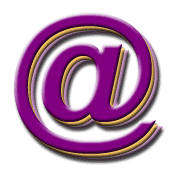人人都知道寫電子郵件地址的時(shí)候,要加一個(gè)@字符,把用戶名和郵件服務(wù)提供商的名字分開。關(guān)于@的起源,說法不一。它的讀法就更加是五花八門,而且不乏有趣的聯(lián)想哦!
 What do you call the @ symbol used in e-mail addresses?
What do you call the @ symbol used in e-mail addresses?
That little "a" with a circle curling around it that is found in email addresses is most commonly referred to as the "at" symbol.
Surprisingly though, there is no official, universal name for this sign. There are dozens of strange terms to describe the @ symbol.
Several languages use words that associate the shape of the symbol with some type of animal.
For instance, some quirky names for the @ symbol include:
apenstaartje - Dutch for "monkey's tail"
snabel - Danish for "elephant's trunk"
kissanhnta - Finnish for "cat's tail"
klammeraffe - German for "hanging monkey"
papaki - Greek for "little duck"
kukac - Hungarian for "worm"
dalphaengi - Korean for "snail"
grisehale - Norwegian for "pig's tail"
sobachka - Russian for "little dog"
Before it became the standard symbol for electronic mail, the @ symbol was used to represent the cost or weight of something. For instance, if you purchased 6 apples, you might write it as 6 apples @ $1.10 each.
With the introduction of e-mail came the popularity of the @ symbol. The @ symbol or the "at sign" separates a person's online user name from his mail server address. For instance, joe@uselessknowledge.com. Its widespread use on the Internet made it necessary to put this symbol on keyboards in other countries that have never seen or used the symbol before. As a result, there is really no official name for this symbol.
The actual origin of the @ symbol remains anenigma.
History tells us that the @ symbol stemmed from the tired hands of the medieval monks. During the Middle Ages before the invention of printing presses, every letter of a word had to be painstakingly transcribed by hand for each copy of a published book. The monks that performed these long, tedious copying duties looked for ways to reduce the number of individual strokes per word for common words. Although the word "at" is quite short to begin with, it was a common enough word in texts and documents that medieval monks thought it would be quicker and easier to shorten the word "at" even more. As a result, the monks looped the "t" around the "a" and created it into a circle-eliminating two strokes of the pen.
Another story tells the @ symbol was used as an abbreviation for the word amphora. Amphora was the unit of measurement that determined the amount held by the large terra cotta jars that were used to ship grain, spices and wine. Giorgio Stabile, an Italian scholar, discovered the @ symbol in a letter written in 1536 by a Florentine trader named Francesco Lapi. It seems likely that some industrious trader saw the @ symbol in a book transcribed by monks using the symbol and appropriated it for use as the amphora abbreviation. This would also explain why it became common to use the symbol in relation to quantities of something.
enigma: 迷,費(fèi)解的事物
(英語點(diǎn)津Annabel 編輯)